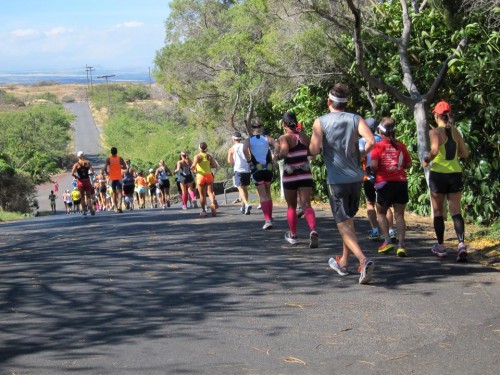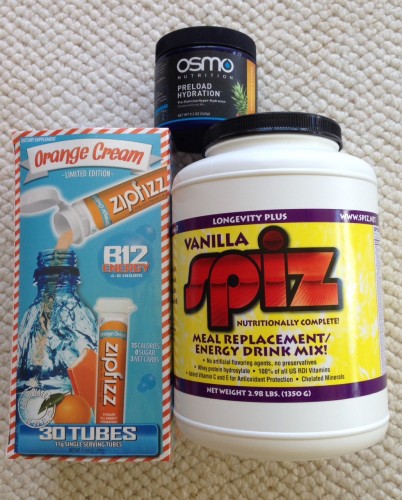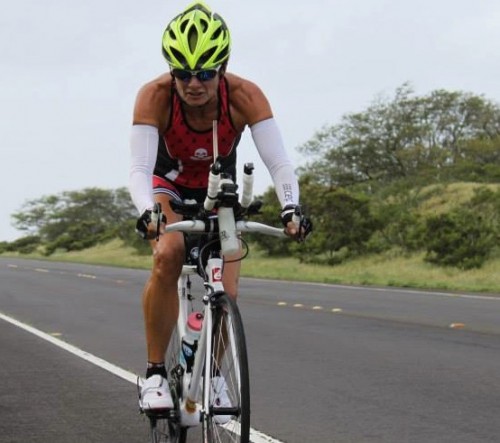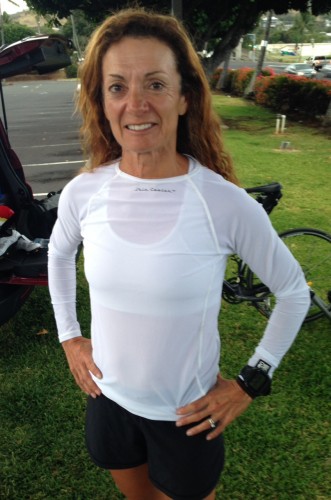Anyone who trains for an endurance triathlon knows that nutrition, hydration and recovery are as important as swimming, biking and running. They all know it, but when it comes to doing it, they are much more diligent about the swim/bike/run than the eat/drink/rest. Myself included.

The Boca Honu Training Weekend typically has a long swim and run on Day 3. This year, it was on Day 2 to hopefully avoid another bike day with high winds.
You would think that after training for and racing eight Ironman races and nine 70.3 events, I would have figured out how to get through a tough training day without bonking. But bonk I did. And it was worse than I’ve ever experienced. On the second day of a 3-day training weekend with 60 other athletes on the Big Island of Hawaii, I was at mile 13 of a 15-mile run when it happened. My head started throbbing, I was dizzy and my body started to cramp–first my feet, then my ankles and calves and up my legs and even around my rib cage. I thought I might collapse right there.
This caused me to have to greatly modify my training for the next several days. This was kind of worrisome considering I was four weeks from my A race, Ironman Brazil. As cathartic as it might be to share more of the gory details, I thought it would be more helpful to share what I didn’t do–should have done–and will do next time to avoid this in the future.
1. Prepare and plan for a major training day as carefully as I would for a race day. In every endurance training plan, there are heavy training blocks. I do not prepare for them as I would if I were doing a race even though the stress on my body can be just as intense. After all, “it’s just training”. For a race, I rest and/or taper, pre-hydrate and load my glycogen stores. In preparation for this weekend, I didn’t properly do any of these things.
2. Eat enough on training days. As a heavy kid and teenager, I am somewhat afraid of calories. That is a stupid way to think when you’re training. Since you will use somewhere between 400 and 600 calories per hour during tough training, calories get used up fast. The day that I bonked, I ate about 400 calories at 6am in the form of half of a peanut butter and banana sandwich. We did a swim race in the ocean at 7am and then started the run at 9am. At around 10:15 I had one gel and another one at around 11:00. So, that’s about 600 calories to fuel the whole morning from 6am to noon. Enough for some, but not enough for me, especially considering that I likely came into the day already depleted. As I was sitting along side the road, one of my friends offered me an energy bar. Reaffirming my need for calories, I felt a bit better after eating it and was able to make it back to the hotel.
3. Hydrate better before, during and after. All of us weighed ourselves before the run and again after the run. I weighed in at 124.6 and then 119.7. That’s a loss of 5 pounds and probably more like 6-7 considering my clothes were dripping wet, adding 1-2 pounds to my finish weight. A fluid loss of nearly 5% is significant and is bound to impact performance and even health.
I check my urine to make sure it’s pretty clear the days before the race as a sign of adequate hydration. It can be tricky, because some of the supplements I take make it various pretty shades of yellow. For a race, I take OSMO Preload Hydration as prescribed for two days before the race. I find that it helps my body retain water. In fact, it’s not unusual for me to gain 3-4 pounds when I do this. Of course, even though I had my OSMO Preload Hydration with me for the weekend, I didn’t use it. After all, “it’s only training”. I took a drink at the 4 aid stations along the route, but I likely only consumed 6-8 ounces of water each time. For a race, I carry a 12-ounce bottle of Zip Fizz with me at the start of an Ironman run and always have another one in my special needs bag to supplement what I get at aid stations.

I depend on these three products for good hydration and nutrition. But, not on this day!
4. Consider the effect of one training day on the next. Before a race, I rest and increase the glycogen stores in my body by increasing carbohydrates in my diet. And during a race, I use the bike leg to keep my nutrition and hydration in good shape to get me through that event, and also to launch me strongly into the run. The day before this long run day, we did a 45-mile ride to Hawi. It was cool and extraordinarily windy. I brought two bottles of SPIZ with me, planning to consume both of them during the ride. That would give me a well-balanced 1000 calories, plus electrolytes, and set me up for the brick run we did afterwards. Since it was cool and windy, I only drank one bottle of SPIZ and I had a very strong 5-mile brick run after the bike. Winning! What I wasn’t considering is that my body was now a bit depleted when it needed to be ready for a tough swim/run the next day. I should have had that second bottle of SPIZ and also hydrated more in preparation for Day 2.
5. Don’t underestimate how tough my training is. Since the bike ride to Hawi was short and it was cool, I didn’t think it was a big deal. But winds of 25-35 mph with crosswind gusts up to 50 mph, made the ride more taxing than it may have seemed. I was sweating and exerting myself, but this was masked by my focus on staying on the shoulder instead of going into the guardrail, into the boulders and bushes, or into traffic.

As much as I was trying to relax, I was working hard to keep upright and on the shoulder of the road.
6. Focus on recovery between hard training days. I typically drink chocolate milk, rehydrate really well and have a good meal after a tough day. I didn’t do that after the ride to Hawi since it wasn’t a “hard” workout (and it was “just training”). I also didn’t use my REAP recovery boots for the same reason. If I were preparing for a race, or if I had been in a “prepare for the next day” frame of mind, I would have done all of these things.
7. Cover up on hot, sunny days. I typically run in a running top and shorts. And the hotter it is, the more logical it had seemed to me that fewer clothes should be cooler. But, au contraire! On this day, one of the hottest and sunniest training days of the year, I wore a black running top and red running shorts. I should have worn a dry-fit running shirt to keep the sun from beating down directly on my skin and easily evaporating the perspiration my body was working so hard to produce. After my bonk, I bought a DeSoto Cooler shirt and will now be wearing that on hot, sunny days.

I wore this shirt on a hot, sunny day to try it out. It held some moisture in, keeping me cooler, without becoming super wet and heavy.
8. Rest up in preparation. Almost every training plan I’ve ever seen has an easy or an off day before a heavy training block. My coach, KC Carlberg, who has successfully coached me to multiple Ironman podium finishes, had an off day noted in BIG, BOLD LETTERS for the day before this 3-day weekend. But I decided to go on an easy 5-mile run with my husband instead. That run mattered.
9. Do what’s right for myself, not what I see other athletes doing. Many triathletes are Type A, competitive people. They are NICE Type-A , competitive people, but you can’t get around the fact that many think about their performance compared to others. I am typical. I don’t like to fall behind the people I typically keep pace with. But, we all have different goals. And some people are having a great day and others are having a crummy day. Measuring myself against others is self-defeating in training. I have to continue to put my ego aside and train for myself, resisting the urge to push beyond my plans and what I’m capable of doing that day.
10. Know when to pull the plug. As I started to bonk, I should have stopped and asked for a ride back to the hotel right then. Instead, I tried to continue on as things got progressively worse over the next half hour. (Insert ego here.) When I finally sat down and mentioned to everyone who passed by that “it would be nice if you asked Rick to come get me”, I was relieved. And fortunately, I was okay.

I look happy at around mile 12. But look at how wet my clothes are. Bonk coming soon!
The plan for the third day of the training weekend was a 75 mile ride, followed by a 4 mile run. After a long talk with my coach the evening after my bonk, my training was modified to be a 25 mile ride and a 30 minute swim. This time, I listened to my coach. And as with every “failure” I’ve had, I’ve become just a little smarter about Ironman training.










Leave a Comment